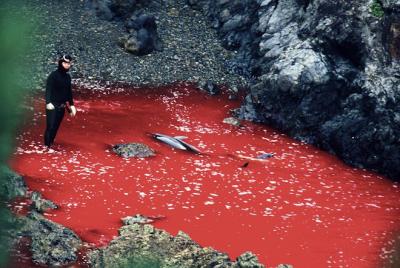

by Alexa Erickson, Collective Evolution
When we think of endangered species, one of the first things that comes to mind is how human activity has played a part. From deforestation and climate change to toxic chemicals in the air and water, the reality is grim. But just as terrible is the unnecessary practice of poaching. Take “Drive Hunts,” for example.
Drive hunts involve herding dolphins and small whales at sea into a cove area, where they are then either killed or selected for live sale to marine parks and aquaria across the globe. Hunts in Japan comprise the biggest single slaughter of whales and dolphins in the world. It has even been documented that some dolphins take more than 30 minutes to die. But to keep the controversial backlash to a minimum, curtains are pulled across the shoreline to hide the killing process from the public.
In the cove of Taiji in Japan, some dolphins are chosen for use in dolphin shows; however, many die of shock before even making it to be transported to their new lives. This annual dolphin drive and slaughter is now back, having begun on September 1st. So as dolphins swim off the southwest coast of Japan, they may, indeed, be greeted with a heart-breaking, end-of-summer welcome.
It’s not only dolphins that are targeted, it’s:
- Striped dolphins
- Bottlenose dolphins
- Pantropical spotted dolphins
- Risso’s dolphins (also called grampus)
- Pilot whales
- Rough-toothed dolphins
- Pseudo orcas (also called false killer whales)
- Pacific white-sided dolphins
- Baird’s beaked whales
- Dall’s porpoises
Former dolphin trainer and current dolphin activist Ric O’Barry heads the advocacy group called the Dolphin Project. This will be the 14th year his group will be on the ground in Taiji monitoring the roundups and shooting video of the drives, hoping to raise awareness of dolphin slaughter and highlight the role the captive marine mammal industry plays in the process.
“Each year it gets more challenging, as they keep erecting barricades and restricting access to block our views, yet we don’t quit,” explained O’Barry, the star of the 2009 Oscar-winning documentary The Cove. “However, we see more and more people interested in learning about the slaughters and getting more involved to end the hunts and the captivity of dolphins for entertainment, which is a very positive development and one we hope continues to grow.”
However, this is the first time O’Barry will not be joining the rest of the group. In February, Japanese officials detained and deported him from entry back into the country because of a supposed violation of his tourist visa. The arrest is thought to be an attempt by Japanese officials to silence one of the loudest critics of the dolphin hunts.
“He was deported because the Taiji dolphin slaughter is a huge international embarrassment to Japan, and Ric is the most vocal protester,” said Louie Psihoyos, director of The Cove and executive director of the Ocean Preservation Society. “He didn’t violate any Japanese laws, but he brings worldwide attention to one of the most brutal animal atrocities in the world.”
O’Barry is currently trying to fight the deportation decision, and his case is currently pending in the Japanese court system. “We are awaiting further developments,” explained Christine Gau, Dolphin Project spokeswoman. “He will not be allowed to return to Japan until there is a resolution.”
O’Barry and the Dolphin Project must now, despite this setback, continue to raise awareness and fight to protect the dolphins from this tragic annual event, which they believe captures around 150 of the best-looking dolphins to be sold to marine parks in Japan, China, and other countries, while hundreds more are killed and sold for their meat each season.
Who Is Killing The Dolphins In Japan?
A statement from savedolphins.eii.org/ sums it up best:
“One often encounters this statement: “The Japanese are killing the whales and dolphins!” But it is not the Japanese people who are doing this – only a very small fraction of Japanese people are engaged in these hunts. The captures of dolphins in the small fishing village of Taiji are carried out by about 24 hunters. They kill the dolphins with permits from the Japanese government. Another two-dozen or more help with the slaughter on the beach, the carving up of the meat, and the distribution of the meat. Most of the people in the town of Taiji have nothing to do with the hunts. The majority of people in Japan are totally unaware of this annual government-sanctioned dolphin blood bath because of the media blackout on this issue in Japan. Unfortunately, the Japanese people only hear the propaganda of the Japan Fisheries Agency, and not the facts concerning the importance and intelligence of dolphins and whales.
What Can You Do?
Savedolphins.eii.org notes that the hunts are legal and sanctioned by the Japanese government and that Japanese laws exempt seafood (including dolphin meat) from meeting health restrictions on mercury content. These barriers make lawsuits against the hunts very difficult to succeed. The Japanese courts are notoriously slow and conservative. We continue to work with lawyers in Japan to see if there is a way to address these key issues. Information on the Taiji Whale Museum lawsuit can be found here, here, and here.
You can support an organization like this with their quest, or the dozens of others who are doing the same thing to try and stop this horrible atrocity, so please consider donating a little bit to the cause if you are able. (Just click on their website above).

